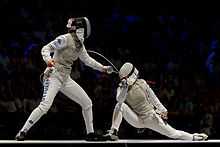Foil (fencing)

A foil is one of the three weapons used in fencing, all of which are metal. It is flexible, rectangular and weighs under a pound. As with the épée points are only scored by contact with the tip, which is capped with a spring-loaded button to detect points in electrically scored tournaments. A foil fencer's uniform features the lamé, a vest, electrically wired to record hits in such cases. It is the most commonly used weapon in competition.
Women were only able to compete with the foil until recently.
Electric and nonelectric foils
The components common to both varieties are the pommel, grip, guard, thumb pad, and blade.
There is the nonelectric foil is known as "steam" or "dry", and an electric. Both varieties are capped with a plastic or rubber piece, with a button at the tip in electric blades. A judge is required to determine the victor in a tournaments with nonelectric foils.
The Fédération Internationale d'Escrime and most national organisations require electric scoring apparatus, although some organizations still fence competitively with nonelectric swords. Nonelectric ones are primarily used for practice.
There are also a range of plastic swords made by varying manufacturers for use by juniors.
Blade
Foil have standardized, tapered, quadrangular (rectangular) blades that are made of tempered and annealed, low-carbon steel and are designed to bend upon striking an opponent in order to prevent both injuries and breakage of the blade. For international competition maraging steel is required. The foil blade is no more than 90 cm in length with a blunted (or foiled) tip. The maximum length of the assembled weapon is 110 cm; the maximum weight is 500g, but most competition swords are lighter, closer to 350g.
The blade itself is subdivided into 3 regions: the foible, or weak, at the last third of the blade near the tip, the medium, and the forte, or strong, is the third of the blade near the guard. Inside of the grip is the tang which is threaded at the end to allow the pommel to fasten the foil assembly together. When an Italian grip is used a ricasso extends from under the guard, inside of the grip's quillons, into the tang.
Guard assembly

The pommel, a type of threaded fastener used to fasten blade, guard, plug, and grip assemblies together, is specific to the type of grip that is used. There are two types of grips used for foils: straight grips with long, external pommels, comprising the French, Italian, and Spanish varieties, and orthopedic, or pistol grips, which are designed to fix the hand in a specific position and have pommels that fit into a countersink in the back of the grip. Foil guards are limited to a diameter of 9.5 to 12 cm in international competition.
Electric foils

Socket
The electric foil contains a socket underneath the guard that connects to the scoring apparatus via the body cord and a wire that runs down a channel cut into the top of the blade. Electric foil sockets are fixed so that the body cord plugs into the weapon at the fencer's wrist. There are two main varieties in use today: the two-prong variety which has unequal diameter prongs and is held in place by a retaining clip, and the single-prong "bayonette" which twist-locks into place.
Tip
The tip of the electric foil terminates in a button assembly that generally consists of a barrel, plunger, spring, and retaining screws. The circuit is a "normally closed" one, meaning that at rest there is always a complete power circuit. Depressing the tip breaks this circuit, and the scoring apparatus illuminates an appropriate light: white or yellow for hits not on the valid target area (depending on the design of the lights on the scoring machine), or either red or green representing hits on the valid target area (red for one fencer, green for the other).
The tip of the foil must be depressed for 15 (± 1) milliseconds while in contact with the opponent's lamé (wire-mesh jacket which covers valid target area) to score a touch. The tip must be able to support a minimum force of 4.90 newtons (500 grams-force) without the circuit breaking. This is tested with a 500g (± 3g) weight.
History

The modern foil is descended from the training weapon for the small-sword, the common sidearm of 18th century gentleman. Rapier and even longsword foils are also known to have been used, but their weight and use were very different.
The foil was invented in France as a training weapon in the middle of the 18th century in order to practise fast and elegant thrust fencing. Fencers blunted the point by wrapping a foil around the blade or fastening a knob on the point ("blossom", French fleuret). In addition to practising, some fencers took away the protection and used the sharp foil for duels. German students took up that practice in academic fencing and developed the Pariser ("Parisian") thrusting small sword for the Stoßmensur ("thrusting mensur").
The target area for modern foil is said to come from a time when fencing was practised with limited safety equipment. Another factor in the target area is that foil rules are derived from a period when dueling to the death was the norm. Hence, the favoured target area is the torso, where the vital organs are.
Scoring
The foil is used as a thrusting (or point) weapon only. Any contact with the side of the blade (a slap or slash) does not result in a score.
Target area
In foil the valid target area includes the torso (including the lower part of the bib of the mask) and the groin. The head (except the lower neck proportion of the mask), arms, and legs are considered off target. Touches made off target do not count for points, but do stop play.

Priority (or right of way)
Foil is a conventional weapon and so is governed by the rules of priority, also known as right of way. As such, points are not necessarily awarded to the first fencer to hit, but to the fencer who hits with priority. Priority is established when one fencer starts a correctly executed attack. An attack which has failed (i.e. has missed or been parried) no longer holds priority. Priority does not automatically pass to the defending fencer, unless the defending fencer parries, at which point priority is given to the defending fencer. Otherwise, at the moment an attack is over, neither fencer has priority. Instead, priority is gained by a fencer making an offensive action, as is always the case. If the attack was parried, the defender has the right to make a riposte, but it must be initiated without indecision or delay. In other words if the defending fencer parries successfully, but then waits and does not immediately riposte, they lose the right of way. Alternatively, they may initiate their own attack if the initial attack missed. The fencer making the original attack may also make a new offensive action, a renewal or remise of the initial attack.
In foil only actions that arrive with priority are considered, unless only one fencer actually hits. Then priority does not matter; the fencer who touched is awarded the point. If the fencer with priority hits off target and the fencer without priority hits on target, then no point is awarded. If both fencers hit on target but one had priority and the other did not, the fencer who had priority is awarded the point.
See also
References
External links
| ||||||||||||||||||||||||||||||||||||||
| ||||||||||||||||||||||||||||||||||||||||||||||||||||||||||||||||||||||||||||||||||||||||||||||||||||||||||||||||||||||||||||||||||||||||
